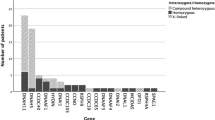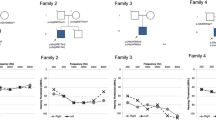Abstract
The term “Bartter syndrome” encompasses a group of closely related inherited tubulopathies characterized by markedly reduced NaCl transport by the distal nephron. At present, five different genetic variants have been demonstrated. The majority of patients with so-called classic Bartter syndrome carry inactivating mutations of the CLCNKB gene encoding the basolateral ClC-Kb chloride channel (Bartter syndrome type III). The purpose of this study was to investigate the underlying mutation in cases of classic Bartter syndrome followed at our center.
Ten patients, including two sisters, with clinical and biochemical features of classic Bartter syndrome were included in the mutational analysis. They originated from different regions of Spain with either Basque or Spanish ancestry. There was no history of consanguineous marriage in any of the kindreds. The parents and siblings of each patient, as well as a population of 300 healthy control adult subjects, were also analyzed. All ten patients were found to be homozygous for an identical missense mutation in the CLCNKB gene, substituting a threonine for an alanine at codon 204 (A204T) in the putative fifth transmembrane domain of the protein. None of the 300 control subjects were homozygous for the A204T allele. Overall, the A204T mutation was detected on 2/600 control chromosomes. Despite sharing a common mutation, the clinical manifestations of the syndrome in the patients varied from lack of symptoms to severe growth retardation.
Demonstration of a point mutation within the CLCNKB gene as the apparently unique cause of Bartter syndrome type III in Spain is highly suggestive of a founder effect. Our results also support the lack of correlation between genotype and phenotype in this disease.


Similar content being viewed by others
References
Rodriguez-Soriano J (1998) Bartter and related syndromes: the puzzle is almost solved. Pediatr Nephrol 12:315–327
Hebert SC (2003) Bartter syndrome. Curr Opin Nephrol Hypertens 12:527–532
Simon DB, Karet FE, Hamdan JM, DiPietro A, Sanjad SA, Lifton RP (1996) Bartter’s syndrome, hypokalemic alkalosis with hypercalciuria, is caused by mutations in the Na-K-2Cl cotransporter NKCC2. Nature Genet 13:183–188
Simon DB, Karet FE, Rodríguez-Soriano J, Hamdan JH, DiPietro A, Trachtman H, Sanjad SA, Lifton RP (1996) Genetic heterogeneity of Bartter’s syndrome revealed by mutations in the K+ channel, ROMK. Nature Genet 14:152–156
Birkenhager R, Otto E, Schurman MJ, Vollmer M, Ruf EM, Maier-Lutz I, Beekmann F, Fekete A, Omran H, Feldmann D, Milford DV, Jeck N, Konrad M, Landau D, Knoers NV, Antignac C, Sudbrak R, Kispert A, Hildebrandt F (2001) Mutation of BSND causes Bartter syndrome with sensorineural deafness and kidney failure. Nature Genet 29:310–314
Schlingmann KP, Konrad M, Jeck K, Waldegger P, Reinalter SC, Holder M, Seyberth HW, Waldegger S (2004) Salt wasting and deafness resulting from mutations in two chloride channels. N Engl J Med 350:1314–1319
Simon DB, Bindra RS, Mansfield TA, Nelson-Williams C, Mendonça E, Stone R, Schurman S, Nayir A, Alpay H, Bakkaloglu A, Rodriguez-Soriano J, Morales JM, Sanjad SA, Taylor CM, Pilz D, Brem A, Trachtman H, Griswold W, Richard GA, John E, Lifton RP (1997) Mutations in the chloride channel gene CLCNKB cause Bartter’s syndrome type III. Nature Genet 17:171–178
Vargas-Poussou R, Huang C, Hulin P, Houillier P, Jeunemaitre X, Paillard M, Planelles G, Dechaux M, Miller RT, Antignac C (2002) Functional characterization of a calcium-sensing receptor mutation in severe autosomal dominant hypocalcemia with a Bartter-like syndrome. J Am Soc Nephrol 13:2259–2266
Watanabe S, Fukumoto S, Chang H, Takeuchi Y, Hasegawa Y, Okazaki R, Chikatsu N, Fujita T (2002) Association between activating mutations of calcium-sensing receptor and Bartter’s syndrome. Lancet 360:692–694
Konrad M, Vollmer M, Lemmink HH, van den Heuvel LP, Jeck N, Vargas-Poussou R, Lakings A, Ruf R, Deschenes G, Antignac C, Guay-Woodford L, Knoers NV, Seyberth HW, Feldmann D, Hildebrandt F (2000) Mutations in the chloride gene CLCNKB as a cause of classic Bartter syndrome. J Am Soc Nephrol 11:1449–1459
Jeck N, Konrad M Peters M, Weber S, Bonzel KE, Seyberth HW (2000) Mutations in the chloride channel gene, CLCNKB, leading to a mixed Bartter-Gitelman phenotype. Pediatr Res 48:754–758
Zelikovic I, Szargel R, Hawash A, Labay V, Hatib I, Cohen N, Nakhoul F (2003) A novel mutation in the chloride channel gene, CLCNKB, as a cause of Gitelman and Bartter syndromes. Kidney Int 63:24–32
Rodríguez-Soriano J, Vallo A, Castillo G, Oliveros R (1981) Renal handling of water and sodium in infancy and childhood: a study using clearance methods during hypotonic saline diuresis. Kidney Int 20:700–704
Rodríguez-Soriano J, Vallo A, Oliveros R (1978) Bartter’s syndrome presenting with features resembling renal tubular acidosis. Improvement of renal tubular defects by indomethacin. Helv Paediatr Acta 33:141–151
Jentsch TJ, Stein V, Weinreich F, Zdebik AM (2002) Molecular structure and physiological function of chloride channels. Physiol Rev 82:503–568
Saito-Ohara F, Uchida S, Takeuchi Y, Sasaki S, Hayashi A, Marumo F, Ikeuchi T (1996) Assignment of the genes encoding the human chloride channels, CLCNKA and CLCNB, to 1p36 and of CLCN3 to 4q32-q33 by in situ hybridization. Genomics 36:372–374
Waldegger S, Jentsch TJ (2000) Functional and structural analysis of ClC-Kb channel involved in renal disease. J Biol Chem 275:24527–24533
Díez O, Osorio A, Durán M, Martinez-Ferrandis JI, de la Hoya M, Salazar R, Vega A, Campos B, Rodriguez-Lopez R, Velasco E, Chaves J, Diaz-Rubio E, Jesus Cruz J, Torres M, Esteban E, Cervantes A, Alonso C, San Roman JM, Gonzalez-Sarmiento R, Miner C, Carracedo A, Eugenia Armengod M, Caldes T, Benitez J, Baiget M (2003) Analysis of breast/ovarian cancer patients: a high proportion of mutations unique to Spain and evidence of founder effects. Hum Mutat 22:301–312
Del Castillo J, Moreno-Pelayo MA, Del Castillo FJ, Brownstein Z, Marlin S, Adina Q, Cockburn DJ, Pandya A, Siemering KR, Chamberlin GP, Ballana E, Wuyts W, Maciel-Guerra AT, Alvarez A, Villamar M, Shohat M, Abeliovich D, Dahl HH, Estivill X, Gasparini P, Hutchin T, Nance WE, Sartorato EL, Smith RJ, Van Camp G, Avraham KB, Petit C, Moreno F (2003) Prevalence and evolutionary origins of the del (GJB6-D13S1880) mutation in the DFNB1 locus in hearing impaired subjects: a multicenter study. Am J Hum Genet 73:1452–1458
Cusco I, López E, Soler-Botija C, Jesus Barcelo M, Baiget M, Tizzano EF (2003) A genetic and phenotype analysis in Spanish spinal muscular atrophy patients with c.399_402del AGAG, the most frequently found subtle mutation in the SMN1 gene. Hum Mutat 22:136–143
Gómez-Garre P, Sanz Y, Rodríguez de Cordoba SR, Serratosa JM (2000) Mutational spectrum of the EPM2A gene in progressive myoclonus epilepsy of Lafora: high degree of allelic heterogeneity and prevalence of deletions. Eur J Hum Genet 8:946–954
Cormand B, Grinberg G, Gort L, Chabas A, Vilageliu L (1998): Molecular analysis and clinical findings in Spanish Gaucher disease population: putative haplotype of the N370S ancestral chromosome. Hum Mutat 11:295–305
Montfort M, Vilageliu L, García-Giralt N, Guidi S, Coll MJ, Chabas A, Grinberg D (1998) Mutation 1091delC is highly prevalent in Spanish Sanfilippo syndrome type A patients. Hum Mutat 12:274–279
Ezquieta B, Cueva E, Oyarzabal M, Oliver A, Varela JM, Jariego C (2002) Gene conversion (655G splicing mutation) and the founder effect (Gln318stop) contribute to the most severe point mutations in congenital adrenal (21-hydroxylase deficiency) in the Spanish population. Clin Genet 62:181–188
Sanchez B, Robledo M, Biarnes J, Saez ME, Volpini V, Benitez J, Navarro E, Ruiz A, Antinolo G, Borrego S (1999) High prevalence of the C634Y mutation in the RET proto-oncogene in MEN 2A families in Spain. J Med Genet 36:68–70
Schurman SJ, Perlman SA, Sutphen R, Campos A, Garin EH, Cruz DN, Shoemaker LR (2001) Genotype/phenotype observations in African Americans with Bartter syndrome. J Pediatr 139:105–110
Mount DB, Hoover R, Herbert SC (1997) The molecular physiology of electroneutral cation-chloride cotransport. J Membr Biol 158:177–186
Simon DB, Nelson-Williams C, Bia MJ, Ellison D, Karet FE, Molina AM, Vaara I, Iwata F, Cushner HM, Koolen M, Gainza FJ, Gitleman HJ, Lifton RP (1996) Gitelman’s variant of Bartter’s syndrome, inherited hypokalemic alkalosis, is caused by mutations in the thiazide-sensitive Na-Cl cotransporter. Nature Genet 12:24–30
Simon DB, Vallo A, Lifton RP, Rodriguez Soriano J (1998) A CLCNKB mutation causes type III Bartter’s syndrome in Spain. Pediatr Nephrol 12(7):C6
Acknowledgements
Preliminary data on this subject have been reported in abstract form [29]. This study was partly supported by a grant (C03/08) from the FIS of the Instituto Carlos III, Red de Centros RCMN, Madrid, Spain. Dr. José Ramón Bilbao is a FIS researcher supported by a fellowship (nº 99/3076) from the Spanish Ministry of Health. Dr. Gustavo Pérez de Nanclares is supported by a Predoctoral fellowship from the Department of Education, University and Research of the Basque Government.
Author information
Authors and Affiliations
Corresponding author
Rights and permissions
About this article
Cite this article
Rodríguez-Soriano, J., Vallo, A., Pérez de Nanclares, G. et al. A founder mutation in the CLCNKB gene causes Bartter syndrome type III in Spain. Pediatr Nephrol 20, 891–896 (2005). https://doi.org/10.1007/s00467-005-1867-z
Received:
Revised:
Accepted:
Published:
Issue Date:
DOI: https://doi.org/10.1007/s00467-005-1867-z




